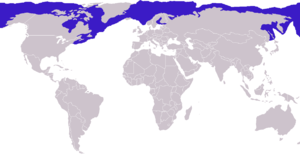Ringed Seal
Ringed Seal, Pusa hispida
| Ringed Seal | |
|---|---|

| |
| Head of a ringed seal, Pusa hispida. | |
| Scientific classification | |
| Kingdom: | Animalia
|
| Phylum: | Chordata
|
| Class: | Mammalia
|
| Order: | Carnivora
|
| Family: | Phocidae
|
| Genus: | Pusa
|
| Species: | P. hispida
|

| |
| Ringed seal range map. | |
| Synonyms | |
| |
← Polar Life | ← More Animals | ← More Mammals
The ringed seal, Pusa hispida (formerly Phoca), is the most abundant marine mammal in the Arctic, with a population size of at least one million animals. It is also the smallest seal; adults measure about 1.5 m long and weigh only 50 kg. They are brown to bluish black in colour with irregular creamy rings. Their scientific name, hispida, means "rough, bristly, or hairy" and refers to their coarse hair.
Contents
General Information and Adaptations
The Ringed Seal is one of the most important species of seal for Inuit, and has been a member of the Arctic ecosystem for millennia.[1] They are the smallest species of seal and can live for 40 years or more.[1] These unique seals can dive as deep as 45 m, and for as long as 30 minutes![1]
Ringed seals feed primarily on fish – such as polar cod and herring – that provide enough resources to form the thick layer of blubber that keeps them warm. This layer of blubber also makes them attractive prey to polar bears, orcas, sharks, humans, and occasionally walrus.
Behaviour and Distribution
Ringed seals are usually solitary, staying within 20 km of the coast, where they live on land-fast ice. They often venture into fiords, bays, and estuaries in search of food.
As ice forms in the fall, each seal scrapes out a number of breathing holes with the strong claws on its front flippers. In early April, mature females enlarge one of their breathing holes and haul themselves out of the water. They then excavate tunnels and chambers in the snow on the pack ice where they give birth to their pups. The mother seals will build snow shelters surrounding their breathing holes to protect their young from the arctic cold and predation. At birth, the white pups weigh just 4 kg, but they quadruple their weight in just one month and enter the water within six weeks.
Traditional Names and Use
External resources
| Name | ID |
|---|---|
| NCBI Taxonomy | 9718 |
| WikiSpecies | Pusa hispida |
| Wikipedia | Ringed Seal |
| iNaturalist | Pusa hispida |
| GBIF | 5219369 |
| BOLD | 68860 |
